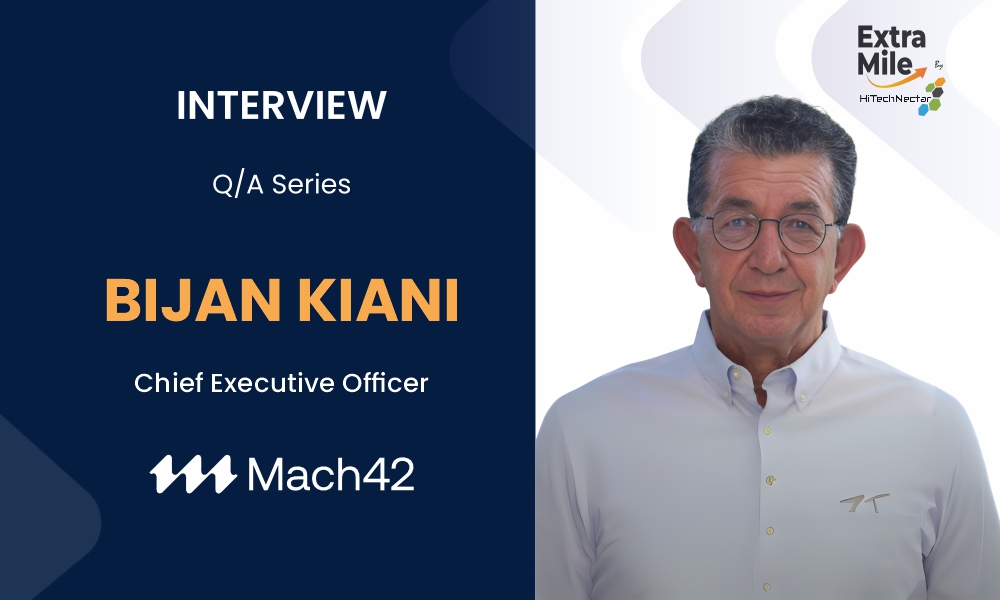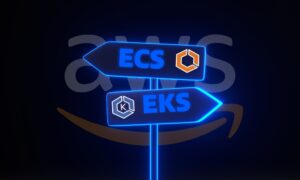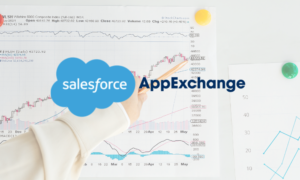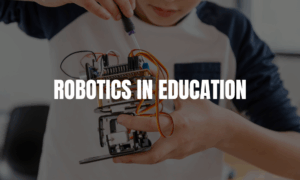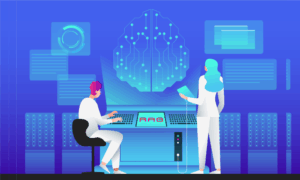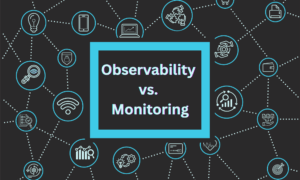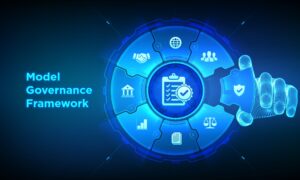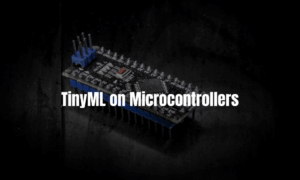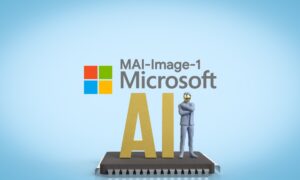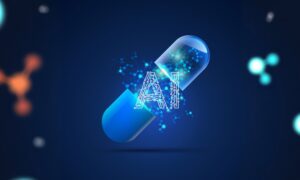ExtraMile by HiTechNectar is a renowned and best-in-class interview series hosting the tech industry’s innovators and game-changers. We’re here to connect our audience with industry leaders discussing their inspiring career journeys, latest trends, company successes, and everything that makes an impact in today’s digital world.
In the latest interview, Bijan Kiani, CEO of Mach42, joined us to simplify the concept of AI-driven approach to verification. Mach42, a spinout from Oxford University, is setting the bar of excellence in verification acceleration with AI and machine learning technology.
Bijan, a PhD holder in Electrical Engineering, is a sharp visionary with standout technical and business leadership skills. As the CEO of Mach42, Bijan firmly oversees all product groups, marketing, customer support, and business development. Under his expertise, Mach42 is driving innovation, growth, and discovering new possibilities.
Let us explore Bijan’s initial career journey, the company’s AI-driven verification acceleration, and more about the Discovery Platform, including its benefits and trends in the software and semiconductor industries.
Welcome, Bijan! Glad to have you here with us!
1. Your educational and professional background is super impressive. How did your PhD in electrical engineering impact your approach to business, particularly in areas such as semiconductor product management?
Bijan. I was fortunate to gain early exposure to applications of 8-bit microprocessors during my master’s studies. Later, I worked with complex analog devices to implement digital signal processing (DSP) algorithms across various semiconductor technologies, including designing custom devices specifically for DSP applications.
Witnessing the rapid advancements in the industry over just a few short years confirmed for me that this technology was evolving at an exceptional pace—clearly reflecting the continued relevance of Moore’s Law.
2. Currently leading as Chief Executive Officer at Mach42, your role includes overseeing product groups, marketing, sales, customer support, and more. How do you perfectly balance these critical areas of business? Please share a few thoughts on this.
Bijan. As CEO of Mach42, balancing product, marketing, sales, customer support, and other critical functions requires a clear vision, disciplined prioritization, and a strong leadership team.
First and foremost, I focus on aligning all functions around our core mission and strategic goals. When everyone—from product to customer success—shares a common purpose, collaboration becomes more natural, and decision-making becomes faster and more focused.
I rely heavily on empowered functional leaders who bring deep expertise in their domains. My role is not to micromanage, but to set direction, remove obstacles, and ensure that cross-functional alignment happens continuously. Regular communication rhythms—such as weekly leadership syncs and quarterly planning—keep us coordinated and adaptable.
Prioritization is also key. At any given time, some areas require more direct involvement than others. For example, during a major product launch, I may lean more into marketing and sales. At other times, customer feedback might drive more focus on support and product iteration. I stay close to the customer voice and market signals to guide where I should place my energy.
Lastly, I’ve learned that balance isn’t about doing everything equally—it’s about being intentional with time, trusting the team, and keeping the bigger picture in view.
3. Bijan, what’s your go-to-market strategy for the Discovery Platform? Are there specific segments of the market you are targeting?
Bijan. Our go-to-market strategy for the Discovery Platform is centered around delivering a modern, AI-driven approach to verification that significantly reduces time to market and provides measurable ROI.
We are targeting two key segments within the verification space: semiconductor design and engineering verification.
For semiconductor design, our platform accelerates complex analog verification by fusing advanced AI techniques with deep analog design expertise—an approach that addresses long-standing bottlenecks in the verification process.
In the engineering domain, we apply the same core technology to tackle multi-physics verification challenges, enabling a more unified and efficient verification workflow across different physical domains.
By combining cutting-edge AI with domain-specific knowledge, we’re not only modernizing the verification process but also creating scalable value across both target segments.
4. Congratulations on being the finalist for “AI Innovation of the Year” and “Innovative Tech Company of the Year!” What do these achievements mean for the company’s success?
Bijan. Thank you! We’re honored to be named a finalist for both “AI Innovation of the Year” and “Innovative Tech Company of the Year.” These recognitions are a strong validation of the vision, technology, and hard work our team has invested in building something truly transformative.
For us, this isn’t just about awards—it’s about momentum. These nominations reinforce that our AI-driven approach to verification is not only resonating within the industry but also solving real, high-impact problems. It’s helping us build credibility with partners, customers, and investors, and it’s accelerating conversations around adoption.
Ultimately, this recognition energizes our team and strengthens our belief that we’re on the right path—delivering innovation with real-world value.
We’re also proud to share that our Discovery Platform has been named a finalist for an Elektra Award, organized by Electronics Weekly—further validating the impact and innovation of our technology across the industry.
5. What kinds of simulation tasks or industries are seeing the most significant benefits from Mach42’s platform today? Could you elaborate on this?
Bijan. In the semiconductor industry, our Discovery Platform is delivering significant benefits by accelerating the verification of complex analog designs. It enables designers to perform exhaustive analysis across different operating modes and process corners—something that is often infeasible with traditional solutions within tight project schedules. This leads to faster time to market and higher-quality products.
Additional differentiator is the platform’s ability to automatically generate interoperable models, such as in Verilog-A format, which can be used with traditional SPICE simulators for higher-level system verification. This not only enhances productivity but also ensures compatibility with existing tool chains and workflows.
In the engineering space, we’re bridging physics and AI to accelerate innovation in multi-physics simulation. Multi-physics involves the simultaneous simulation of multiple interacting physical phenomena—such as fluid flow, heat transfer, structural mechanics, and electromagnetism. Traditional tools often analyze these separately, but real-world systems demand a unified approach. Our platform enables engineers to explore these complex interactions more efficiently, driving faster insights and breakthroughs in product design and development.
6. Security can’t be overlooked in any aspect! How do you mitigate the data security and intellectual property concerns when customers run simulations on the cloud through the Discovery Platform?
Bijan. Security and data privacy are foundational to the Discovery Platform. We recognize that simulation data often contains highly sensitive IP, and customers must have full confidence that their data remains secure—especially in cloud-based environments.
To address this, we’ve built decentralized AI directly into our architecture. Unlike traditional centralized training approaches, our platform uses a client-server model with separate components for data management, model training, and inference. This allows for tight integration with customer simulation tools, while ensuring that sensitive data never leaves the customer’s controlled environment.
Customers have the flexibility to deploy the entire solution—data, training, and inference—within their private cloud or on-premises infrastructure. This means model training can happen locally, while still benefiting from our accelerated AI capabilities, without exposing proprietary data to the public cloud.
By combining the power of AI with a secure, decentralized deployment model, the Discovery Platform delivers both the flexibility and security needed to solve critical verification challenges—without compromising intellectual property.
7. You emphasize achieving high accuracy with minimal data, how is this possible compared to traditional ML models that require large datasets?
Bijan. Traditional machine learning models typically rely on large volumes of labeled data to achieve accuracy—something that’s often impractical or cost-prohibitive in semiconductor and engineering simulations, where data generation is computationally expensive and time-consuming.
At Mach42, we’ve taken a different approach. The Discovery Platform achieves high accuracy with minimal data by combining two key innovations:
- Intelligent Sampling (Active Learning): Instead of randomly generating massive datasets, our platform strategically selects the most informative simulation points. This dramatically reduces the number of simulations needed while ensuring high-quality coverage of the design space.
- Specialized Neural Network Architectures: Our AI models are purpose-built for design and simulation environments, enabling them to learn more effectively from smaller, high-value datasets. This allows for accurate prediction and generalization without overfitting.
As a result, the Discovery Platform can:
- Perform exhaustive verification of complex analog and mixed-signal designs in minutes
- Explore entire design spaces and flag violations that would be missed in conventional workflows
- Generate interoperable models (e.g., Verilog-A) for use in system-level simulations—all with significantly fewer data points
This capability is already delivering tangible ROI to our customers—through faster time-to-market, improved product quality, and more confident design decisions. And as more customers adopt our technology, we’re uncovering new, previously infeasible use cases across PMIC, SerDes, RF, and beyond.
8. What emerging trends in enterprise software development and the semiconductor industry do you believe will be booming in the coming years? Can you share your take on this?
Bijan. Certainly—there are some powerful shifts underway in both enterprise software and the semiconductor industry that I believe will define the next decade.
In enterprise software, three major trends stand out:
- AI-Native Software Architectures: We’re moving beyond “AI-enhanced” tools to software that’s fundamentally designed around AI from the ground up. This includes platforms that use AI not just for insights, but for core functionality—automation, decision-making, and adaptive systems.
- Decentralized and Privacy-Preserving AI: With increasing sensitivity around data ownership and IP, enterprises are demanding more secure, flexible AI solutions. Technologies like federated learning, edge AI, and on-prem AI training are gaining serious traction.
- Verticalized Platforms: Generic enterprise tools are giving way to highly specialized platforms that are deeply integrated into specific industries and workflows. Companies are looking for tools that “understand” their domain—this is particularly true in engineering and semiconductor environments.
In the semiconductor industry, the key trends I see booming are:
- AI for Chip Design and Verification: AI will play an increasingly central role in accelerating verification, test, and design optimization—turning what used to be months of manual work into hours or even minutes. This aligns closely with what we’re doing at Mach42.
- System-Level Simulation and Co-Design: As chips become more complex (think chiplets, 3D ICs, heterogeneous integration), system-level simulation will become critical. Teams will need to co-optimize electrical, thermal, mechanical, and software aspects from day one.
- Open Source and Interoperability: There’s growing momentum around open standards, open-source tooling, and interoperable model formats. This will open up innovation and reduce the vendor lock-in that has historically slowed progress.
In summary, I believe the convergence of AI, domain-specific platforms, and secure, decentralized architectures will reshape both enterprise software and semiconductor workflows. Those who can combine deep domain knowledge with cutting-edge AI will be the ones driving the next wave of innovation.
Explore Our Other Insightful Interviews:
